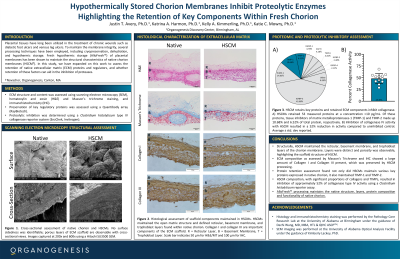Laboratory Research
(LR-001) Hypothermically Stored Chorion Membranes Inhibit Proteolytic Enzymes Highlighting the Retention of Key Components Within Fresh Chorion

Placental tissues have long been utilized as a covering for a variety of chronic wounds including diabetic foot ulcers and venous leg ulcers. To maintain integrity, several processing techniques have been employed, including cryopreservation, dehydration, and hypothermic storage. Fresh hypothermic storage (AlloFresh™) of placental membranes has been shown to maintain the structural characteristics of chorion membranes (HSCM†). In this study, we have expanded on this work to assess retention of native extracellular matrix proteins and regulators, and capacity for protease and collagenase inhibition.
Methods:
ECM structure and content of HSCM membranes were assessed using hematoxylin and eosin (H&E) and Masson’s trichrome staining, immunohistochemistry (IHC), and scanning electron microscopy. Preservation of proteins was assessed using Quantibody arrays (RayBiotech). Protease and collagenase inhibition assays were used to determine the capacity for HSCM to inhibit proteolytic enzymes using trypsin (Pierce) and Clostridium histolyticum collagenase (EnzChek) reporter systems.
Results:
Structurally, HSCM maintained reticular, basement, and trophoblastic layers. IHC found HSCM retained ECM proteins including Collagen I and Collagen III, and Quantibody arrays confirmed retention of protease inhibitors, TIMP-1 and TIMP-2. Collagenase reporter assays showed greater than 55% inhibition of collagenases at 30 minutes. By maintaining both native ECM and protease inhibitors, HSCM maintains the capacity to inhibit proteases comparably to native chorion tissue.
Discussion:
These results build upon our body of work indicating that AlloFresh™ processing maintains the native composition of HSCM.
Trademarked Items: †Novachor®, Organogenesis, Canton, MA
References:

.png)